Plymouth Belvedere
| Plymouth Belvedere | |
|---|---|
.jpg) 1958 Plymouth Belvedere 2-door hardtop | |
| Overview | |
| Manufacturer | Chrysler Corporation |
| Production | 1954–1970 |
| Assembly |
Lynch Road Assembly, Highland Park, Michigan Los Angeles Assembly, Maywood, California |
| Body and chassis | |
| Class |
Full-size (1954–1964) Mid-size (1965–1970) |
| Layout | FR layout |
| Chronology | |
| Predecessor | Plymouth Cranbrook |
| Successor | Plymouth Satellite |
The Plymouth Belvedere is an American automobile model that was produced by Plymouth from 1954 to 1970.
The Belvedere name was first used for a new hardtop body style in the Plymouth Cranbrook line for the 1951 model year. In 1954. the Belvedere replaced the Cranbrook as the top trim and became a full model line with sedans, station wagons and convertible body styles. The Belvedere continued as Plymouth's full-sized car until 1965, when it became an intermediate, and was replaced after the 1970 model year by the Satellite, a name originally used for the top-trim level Belvederes. It was also used in a movie called Christine (1983) it was a 1958 Plymouth Belvedere.
Cranbrook Belvedere 1951–1953
| Plymouth Cranbrook Belvedere | |
|---|---|
.jpg) | |
| Overview | |
| Also called | Dodge Regent (Canada) |
| Model years | 1951-1953 |
| Body and chassis | |
| Class | Full-size car |
| Body style | 2-door hardtop [1] |
| Related |
DeSoto Custom Dodge Custom |
| Powertrain | |
| Engine | 218 cu in (3.6 L) Chrysler Flathead I6 |
| Dimensions | |
| Wheelbase | 114.0 in (2,896 mm) |
Introduced on March 31, the 1951 Plymouth Cranbrook Belvedere is a two-door pillarless hardtop. It was Plymouth's first such body design and was introduced in response to the 1950 Chevrolet Bel Air, and the Ford Victoria, the first two-door hardtop in the low-priced American market.
The Cranbook Belvedere the name for the two-door hardtop version of the Cranbrook and built on the same 118.5 in (3,010 mm) wheelbase. Powering the Belvedere is the Chrysler flathead 217.8 cu in (3.6 L) straight-6 engine with a 7.00:1 compression ratio producing 97 hp (72 kW; 98 PS) (SAE gross).
For 1952, Plymouth kept the Cranbrook Belvedere largely unchanged. The biggest alteration was to the color scheme; to further distinguish the top-level Belvedere from other Plymouths, the two toning now flowed from the roof over the beltline onto the trunk, which has been referred to as the "saddleback" treatment. Two-tone color schemes were "sable bronze" over suede, black over "mint green", and gray over blue. Overdrive was made available as optional equipment in the 1952 Plymouth. In overdrive, the engine made three revolutions for each rear wheel revolution against four without overdrive. The engine was a complete carry over from 1951. Production for 1951 and 1952 totalled 51,266 units.
The Belvedere remained a part of the Cranbrook series through the 1953 model year, which saw all Plymouth models completely restyled. Major style changes include a shorter 114 in (2,900 mm) wheelbase, a one-piece windshield, flush rear fenders, and a lower hood line. In April 1953, Plymouths received the Hy-Drive semi-automatic transmission. The engine was carried over from 1952 with the only enhancement being a slight increase in the compression ratio to 7.10:1, which yielded a rating of 100 hp (75 kW).
A total of 35,185 1953 Belvederes were sold.
Belvedere full-size series
1954
| First generation | |
|---|---|
 1954 Plymouth Belvedere four door sedan | |
| Overview | |
| Model years | 1954 |
| Body and chassis | |
| Class | Full-size car |
| Body style |
4-door sedan [2] 2-door hardtop [2] 2-door convertible [2] 2-door station wagon [2] |
| Related |
DeSoto Firedome Dodge Meadowbrook |
| Powertrain | |
| Engine | 329 cu in (5.4 L) I6 |
| Dimensions | |
| Wheelbase | 114.0 in (2,896 mm) |
The Belvedere replaced the Cranbrook as the top-line offering for 1954. Now, a separate model instead of just a two-door hardtop, it was also available as a convertible, two-door station wagon, and four-door sedan. The two-door hardtop version was now called the "Sport Coupe". 1954 Belevederes featured full-length rocker sill moldings.[2]
Minor styling updates adorned the carry-over body design. For the first time, small chrome tailfins appeared on the rear fenders.
In March 1954, Plymouth finally offered a fully automatic transmission, the Chrysler PowerFlite two-speed. Also new was a larger standard engine: a 230.2 cu in (3.8 L) I6 that was also used by the Dodge Division. Power was now rated at 110 hp (82 kW).
Belvedere production totaled 32,492 for the year.
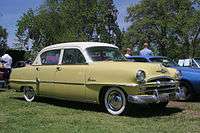 1954 Plymouth Belvedere four door sedan
1954 Plymouth Belvedere four door sedan 1954 Plymouth Belvedere Suburban
1954 Plymouth Belvedere Suburban
1955–1956
| Second generation | |
|---|---|
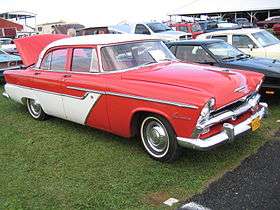 1955 Plymouth Belvedere sedan | |
| Overview | |
| Also called | Dodge Mayfair (Canada) |
| Model years | 1955–1956 |
| Body and chassis | |
| Body style |
2-door sedan [3] 4-door sedan [3] 2-door hardtop [3] 4-door hardtop [3] 2-door convertible [3] 4-door station wagon [3] |
| Related |
DeSoto Powermaster Dodge Coronet |
| Powertrain | |
| Engine |
341.3 cu in (5.6 L) I6 352 cu in (5.8 L) V8 371 cu in (6.1 L) V8 384 cu in (6.3 L) V8 429 cu in (7.0 L) V8 451 cu in (7.4 L) V8 461 cu in (7.6 L) "Golden Commando" twin 4-barrel V8 |
| Transmission | 2-speed automatic |
| Dimensions | |
| Wheelbase | 115.0 in (2,921 mm) |
All Plymouths were treated to a major overhaul for the 1955 model year. This was the first year of Chrysler Stylist Virgil Exner's "Forward Look." The Belvedere returned as top-of-the-line.
For 1956, Plymouth styling evolved from that of the 1955s. Most notable would be the introduction of the first push-button automatic transmission to appear in an American automobile, and a more dramatic rear-end treatment highlighted by a pair of rakish tail-fins. In early 1956, the Fury joined the Belvedere line as a special-edition high-performance coupe. Belvedere remained the top full-line series through 1958. In 1956, Plymouth added seat belts.[4]
In 1956, Chrysler in a public relations campaign took a Belvedere and had turbine engine fitted instead of the standard gasoline engine, and was driven across the US.[5]
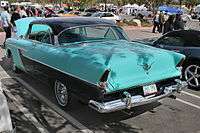 1955 Plymouth Belvedere coupe rear
1955 Plymouth Belvedere coupe rear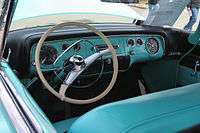 1955 Plymouth Belvedere coupe interior
1955 Plymouth Belvedere coupe interior 1956 Plymouth Belvedere
1956 Plymouth Belvedere
1957–1959
| Third generation | |
|---|---|
 1958 Plymouth Belvedere 2-door Hardtop | |
| Overview | |
| Model years | 1957–1959 |
| Body and chassis | |
| Body style |
2-door sedan [6] 4-door sedan [6] 2-door hardtop [6] 4-door hardtop [6] 2-door convertible [6] 2-door station wagon [6] 4-door station wagon [6] |
| Related |
DeSoto Firesweep Dodge Coronet |
| Powertrain | |
| Engine |
230.2 cu in (3.8 L) I6 241 cu in (3.9 L) V8 260 cu in (4.3 L) V8 273 cu in (4.5 L) V8 301 cu in (4.9 L) V8 318 cu in (5.2 L) V8 340 cu in (5.6 L) V8 350 cu in (5.7 L) "Golden Commando" twin 4-barrel V8 |
| Transmission | 2-speed or 3-speed automatic |
| Dimensions | |
| Wheelbase |
station wagon: 122.0 in (3,099 mm) all other: 118.0 in (2,997 mm) |
The 1957 model year had high sales for the Chrysler Corporation, and for the Plymouth line. Plymouth's design was so revolutionary that Chrysler used the slogan "Suddenly, it's 1960!" to promote the new car.[7]
Standard on all body styles except the convertible was the "Powerflow 6" L-head engine. The convertible was only V8 powered and V8s were available in other Belvederes with an optional "Fury" 301 cu in (4.9 L) version as well as a "High-Performance PowerPAC" at extra cost.[8] A manual transmission was standard with the push-button two-speed PowerFlite optional and the push-button three-speed TorqueFlite automatic also optional on V8 cars.
The Belvedere would once again return as a top level trim for 1958 for the last time. Styling was a continuation from the 1957 models. A big block "B" engine of 350 in3 V8 with dual four-barrel carburetors dubbed "Golden Commando" was optional on all models. For 1959, the Fury became the top range with a full array of sedans and coupes, and the Belvedere became the middle range. The Savoy became the least expensive model, and the Plaza was discontinued.
The convertible was only available in the Belvedere model between 1956 and 1958.
The 1958 Belvedere two-door hardtop gained notoriety from the Stephen King movie Christine (1983). Christine was billed as a '58 Fury, but lacked the "buckskin beige" paint and gold trim that was standard on all Furys that year; instead it sported Belvedere trim (without Belvedere nameplates) and was painted "toreador red" with an "iceberg white" top.
 1957 Plymouth Belvedere Sport Coupe hardtop
1957 Plymouth Belvedere Sport Coupe hardtop- 1958 Plymouth Belvedere 4-door sedan
 1959 Plymouth Belvedere 2-door hardtop
1959 Plymouth Belvedere 2-door hardtop- 1959 Plymouth Belvedere 4-door hardtop
1960–1961
| Fourth generation | |
|---|---|
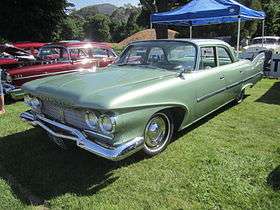 1960 Plymouth Belvedere Sedan | |
| Overview | |
| Model years | 1960–1961 |
| Body and chassis | |
| Body style |
2-door sedan [9] 4-door sedan [9] 2-door hardtop [9] 4-door station wagon [9] |
| Related |
Dodge Polara Dodge Dart Dodge Matador |
| Powertrain | |
| Engine |
230.2 cu in (3.8 L) I6 241 cu in (3.9 L) V8 260 cu in (4.3 L) V8 273 cu in (4.5 L) V8 318 cu in (5.2 L) V8 340 cu in (5.6 L) V8 350 cu in (5.7 L) "Golden Commando" twin 4-barrel V8 |
| Transmission | 2-speed automatic |
| Dimensions | |
| Wheelbase | 118.0 in (2,997 mm) |
Starting in 1960, Belvederes got a brand-new standard inline six-cylinder engine replacing the venerable valve-in-head "flathead" six. Colloquially known as the slant-6, it displaced 225 cu in (3.69 l), featured overhead valves, and a block that was inclined 30 degrees to the right to permit a lower hood line with maximum displacement. This engine used a single-barrel Holley carburetor, and became known for its extremely rugged construction, exceptional reliability and longevity. V-8 engines continued to be optionally available, in displacements of 318 cu in (5.21 l) and 361 cu in (5.92 l).
Unit body construction was introduced throughout the line, though it appeared on certain Plymouths in earlier years such as the 1953 hardtop coupe. This eliminated the frame, and was advertised as Unibody. Under Chrysler president William Newberg, Virgil Exner's styling team was encouraged to go "over the top" with distinctive styling, leading the 1960 models to be popularly dubbed the "jukebox on wheels" and the 1961 models to be widely considered among the ugliest cars ever mass-produced. Despite being remarkable cars in performance, handling, modest weight, and appealing interiors, sales suffered, and Plymouth yielded third place in sales to Rambler.
1962–1964
| Fifth generation | |
|---|---|
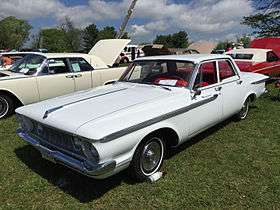 1962 Plymouth Belvedere Sedan | |
| Overview | |
| Model years | 1962–1964 |
| Body and chassis | |
| Body style |
2-door sedan [10] 4-door sedan [10] 2-door hardtop coupe [10] 4-door station wagon [10] |
| Platform | B-body |
| Related | Dodge Custom 880 |
| Powertrain | |
| Engine |
225 cu in (3.7 L) I6 383 cu in (6.3 L) V8 |
The 1962 model year full-size Plymouths were "downsized", with more compact outside dimensions. American car buyers at the time were in the thought mode of "bigger is better", and sales of these models suffered. However, the smaller Plymouth provided greater owner approval in their actual use.[11] A Plymouth Belvedere with six-cylinder engine and automatic transmission was compared to the intermediate-size Ford Fairlane and the compact-size Chevrolet Chevy II in an economy test by Popular Mechanics and the road test concluded that the Belvedere was "a very pleasant transportation package."[12] Another advantage of the smaller and lighter body was in drag racing.
.jpg)
The 1963 and 1964 models used the same unibody platform as the 1962s, but were restyled to look longer and wider.
The 1964 Belvedere (and corresponding Fury hardtop coupes) featured a new "slant-back" roofline that proved to be popular, and sales improved significantly over the previous design.
The 1964 Belvedere was also the car used to introduce the 426 Chrysler Hemi engine, which used a canted large-valve arrangement. This was such a significant high-RPM breathing improvement that Hemi-equipped Plymouth Belvederes won first, second, and third at NASCAR's 1964 Daytona race. One of the winning drivers was Richard Petty.[13]
Belvedere intermediate series
1965–1967
| Sixth generation | |
|---|---|
.jpg) 1966 Plymouth Belvedere sedan | |
| Overview | |
| Model years | 1965–1967 |
| Body and chassis | |
| Body style |
2-door sedan [14] 4-door sedan [14] 2-door hardtop [14] 2-door convertible 4-door station wagon [14] |
| Platform | B-body |
| Related | Dodge Custom 880 |
| Powertrain | |
| Engine |
273 cu in (4.5 L) V8 383 cu in (6.3 L) V8 318 cu in (5.2 L) V8 340 cu in (5.6 L) V8 360 cu in (5.9 L) V8 426 cu in (7.0 L) Hemi V8 |
| Transmission |
3-speed manual 3-speed automatic |
In 1965 Plymouth once again made the Fury a full-size car, and Belvedere ostensibly became the intermediate size offering, though in fact the Belvedere was little changed, and most dimensions and weights remained the same—the Fury was merely enlarged, restoring a full-sized line which Plymouth had been sorely lacking.[15] The Belvedere line was divided into the Belvedere I, Belvedere II and Satellite subseries, the latter available only as hardtop coupe and convertible, and featuring the 273 cu in (4.47 l) "LA block" V-8 as standard equipment. The line was restyled in 1966, and the high-performance GTX was added in 1967.
The 1968 television show Adam-12 featured a 1967 model black and white Belvedere as the standard Los Angeles police cruiser, and in fact the Belvedere regularly won the competition for the LAPD from its inception through 1971.
 1965 Plymouth Belvedere II wagon
1965 Plymouth Belvedere II wagon.jpg) 1967 Plymouth Belvedere 2-door hardtop (customized)
1967 Plymouth Belvedere 2-door hardtop (customized)
1968–1970
| Seventh generation | |
|---|---|
 | |
| Overview | |
| Model years | 1968–1970 |
| Body and chassis | |
| Body style |
2-door coupe [16] 4-door sedan [16] 4-door station wagon [16] |
| Platform | B-body |
| Powertrain | |
| Engine |
273 cu in (4.5 L) V8 383 cu in (6.3 L) V8 318 cu in (5.2 L) V8 340 cu in (5.6 L) V8 426 cu in (7.0 L) Hemi V8 |
| Dimensions | |
| Wheelbase | 116.0 in (2,946 mm) |
| Length | 202.7 in (5,149 mm) |
| Width | 76.4 in (1,941 mm) |
| Height | 54.7 in (1,389 mm) |
The Plymouth Road Runner was introduced as a low-price, high-performance alternative to the GTX, and Richard Petty won the Grand National championship in NASCAR in a Belvedere. The new LA-style lightweight 318 engine was introduced for this year and would remain available on the Belvedere through its life. However the GTX came standard with the 440 CID engine and the Road Runner with the 383 Magnum, with the only engine options being the 440 six barrel or the 426 HEMI engines.
In 1968, the line was restyled with a roofline changed to follow the Charger, standard flip-out rear quarter windows on two-door sedans (that would also be used in 1969), and "Coke bottle styling".
The Belvedere name was dropped at the end of the 1970 model year, replaced by the Plymouth Satellite name originally reserved for higher-end Belvederes. The Satellite itself lasted only through 1974; starting in 1975, the car was renamed Plymouth Fury, and the longer-wheelbase Plymouth Fury became the Gran Fury.
Australian production
The Plymouth Belvedere was also produced by Chrysler Australia. The first model, based on the 1953 US Plymouth, featured a high level of Australian content, with body panels pressed in Chrysler Australia's Keswick facility in South Australia and matched with a 217.8 cubic inch (4107cc) side-valve six-cylinder engine, imported from Chrysler UK.[17] It was produced as a four-door sedan [17] and as a locally developed two-door coupe utility,[18] along with similar Cranbrook and Savoy models, until it was replaced by the Chrysler Royal in 1957.[17] The Belvedere was reintroduced to the Australian market in early 1958 when Chrysler Australia began assembling the current model Belvedere four-door hardtop which was imported from the US in knocked-down form.[19] The 1959 model was equipped with a 318 cubic inch V8 engine and push-button automatic transmission.[20] Chrysler Australia replaced their Plymouth Belvedere, Dodge Custom Royal and De Soto Firesweep models with the Dodge Phoenix in 1960.[21]
Oklahoma centennial
During Oklahoma's 50th anniversary, a new 1957 Plymouth Belvedere was sealed in a concrete enclosure as a time capsule in downtown Tulsa on the grounds of the brand new county courthouse. It was unearthed June 14, 2007[22] during the state's centennial celebrations, and was publicly unveiled on June 15. In line with the Cold War realities of late 1950s America, the concrete enclosure was advertised as having been built to withstand a nuclear attack.[23] The concrete enclosure, however, was not airtight and allowed water to leak in, which caused significant damage to the vehicle.[24]
The controversial[25] televised vehicle customizer Boyd Coddington was to have been the first to start the unburied car, had it been operable.
The car was the prize of a 1957 contest to guess the population of Tulsa in the year 2007. The winning entrant, one Raymond Humbertson, guessed 384,743 versus the actual figure of 382,457. However, Humbertson died in 1979 and now only distant relatives remain.[26]
A second such car, this one a Plymouth Prowler, was encased in a vault in Tulsa's Centennial Park (formerly Central Park) 1998 to celebrate the city's centennial. After it was discovered what had become of the 1957 Belvedere, the Prowler was moved above ground, and a mound was formed over it. It is to be revealed after the same period of time as the Belvedere, in 2048.
Notes
- ↑ Gunnell, John. Standard Catalog of American Cars 1946-1975 (Fourth ed.). pp. 646–649.
- 1 2 3 4 5 John Gunnell, Standard Catalog of American Cars 1946-1975, Revised 4th Edition, page 650
- 1 2 3 4 5 6 John Gunnell, Standard Catalog of American Cars 1946-1975, Revised 4th Edition, page 650-653
- ↑ "Directory Index: Plymouth/1956 Plymouth/album". Oldcarbrochures.com. Archived from the original on September 30, 2010. Retrieved 2011-11-20.
- ↑ "We Drove A Turbine Car Coast-To-Coast." Popular Mechanics, June 1956, pp. 72-76/252.
- 1 2 3 4 5 6 7 John Gunnell, Standard Catalog of American Cars 1946-1975, Revised 4th Edition, pages 653-655
- ↑ "1957 Plymouth prestige brochure". oldcarbrochures.org. pp. 2–3. Retrieved 26 April 2016.
- ↑ "Specifications: 1957 Plymouth brochure". oldcarbrochures.org. p. 12. Retrieved 26 April 2016.
- 1 2 3 4 John Gunnell, Standard Catalog of American Cars 1946-1975, Revised 4th Edition, pages 656-659
- 1 2 3 4 John Gunnell, Standard Catalog of American Cars 1946-1975, Revised 4th Edition, pages 660-665
- ↑ "Smaller Plymouth wins greater owner approval". Popular Mechanics. 117 (2): 95–99, 246, 248, 250. February 1962. Retrieved 2 October 2015.
- ↑ Whipple, James (January 1962). "Drive Comparing Ford Fairlane, Plymouth Belvedere, Chevy II". Popular Mechanics. 117 (1): 104–108, 244, 245. Retrieved 2 October 2015.
- ↑ Redgap, Curtis (2003). "Which came first, the Plymouth or the Petty?". Allpar. Retrieved 2 October 2015.
- 1 2 3 4 John Gunnell, Standard Catalog of American Cars 1946-1975, Revised 4th Edition, pages 665-671
- ↑ "1965, 1966, 1967 Plymouth Belvedere/Satellite and GTX". HowStuffWorks. Retrieved 2011-04-20.
- 1 2 3 John Gunnell, Standard Catalog of American Cars 1946-1975, Revised 4th Edition, pages 671-678
- 1 2 3 David Brimble, Chryslers before the Chrysler Royal, Restored Cars, No 87 (July / August 1991), pages 14-15
- ↑ Larry O'Toole, The Good Old Aussie Ute, page 192
- ↑ Gavin Farmer, Great Ideas in Motion, 2010, page 74
- ↑ News Review, Three Chryslers, Australian Motor Sports, August 1959
- ↑ Gavin Farmer, Great Ideas in Motion, 2010, page 77
- ↑ http://www.unburiedcar.com
- ↑ CNN: link broke. Archived July 6, 2007, at the Wayback Machine.
- ↑ World staff. "Buried Belvedere vault full of water". TulsaWorld. Retrieved 2011-11-20.
- ↑ "Updated: Belvedere rusty but still has personality". TulsaWorld. 2007-06-15. Retrieved 2011-11-20.
- ↑ "Miss Belvedere, you have a winner: But Raymond Humbertson died in 1979". TulsaWorld. 2007-06-23. Retrieved 2011-11-20.
External links
| Wikimedia Commons has media related to Plymouth Belvedere. |
- Allpar: Plymouth Satellite, Plymouth GTX, and Plymouth Belvedere
- View the Unburied Plymouth Belvedere
- Plymouth Belvedere in television and film
- Plymouth sales brochures at www.oldcarbrochures.com
| Plymouth road car timeline, 1950–1970s, United States market — next » | ||||||||||||||||||||||||||||||
|---|---|---|---|---|---|---|---|---|---|---|---|---|---|---|---|---|---|---|---|---|---|---|---|---|---|---|---|---|---|---|
| Type | 1950s | 1960s | 1970s | |||||||||||||||||||||||||||
| 0 | 1 | 2 | 3 | 4 | 5 | 6 | 7 | 8 | 9 | 0 | 1 | 2 | 3 | 4 | 5 | 6 | 7 | 8 | 9 | 0 | 1 | 2 | 3 | 4 | 5 | 6 | 7 | 8 | 9 | |
| Subcompact | Cricket | Horizon | ||||||||||||||||||||||||||||
| Horizon TC3 | ||||||||||||||||||||||||||||||
| Colt | ||||||||||||||||||||||||||||||
| Compact | Colt | Colt | Colt | |||||||||||||||||||||||||||
| Arrow | ||||||||||||||||||||||||||||||
| Valiant | Valiant | Valiant | Valiant | Volaré | ||||||||||||||||||||||||||
| Mid-size | Belvedere | Belvedere | ||||||||||||||||||||||||||||
| Satellite | Satellite | Fury | ||||||||||||||||||||||||||||
| Full-size | Deluxe | Concord | Plaza | Plaza | Plaza | |||||||||||||||||||||||||
| Cambridge | Savoy | Savoy | Savoy | Savoy | Savoy | |||||||||||||||||||||||||
| Special Deluxe | Cranbrook | Belvedere | Belvedere | Belvedere | Belvedere | Belvedere | ||||||||||||||||||||||||
| Fury | Fury | Fury | Fury | Fury | Fury | Gran Fury | ||||||||||||||||||||||||
| Sports | Barracuda | Barracuda | Duster | Sapporo | ||||||||||||||||||||||||||
| Barracuda | ||||||||||||||||||||||||||||||
| Road Runner | Road Runner | Volaré Road Runner | ||||||||||||||||||||||||||||
| GTX | GTX | GTX | ||||||||||||||||||||||||||||
| SUV | Trailduster | |||||||||||||||||||||||||||||
| Van | Voyager | |||||||||||||||||||||||||||||